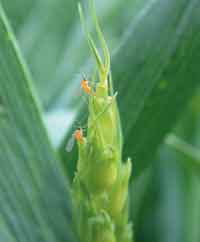Check fields now for orange wheat blossom midge

Monitoring for orange wheat blossom midge in wheat crops on a field-by-field basis remains important even though larvae levels in soils are at their lowest levels since 2004 (see box below).
Pupation from the larval stage into adult midges, which requires soil temperatures above 13C and sufficient moisture, had only just begun, according to last week’s monitoring, ADAS entomologist Mike Lole said on Tuesday [1 June].
“Risk at the moment isn’t high, but the next week will be critical. We’ve had rain and soil temperatures above 13C, so we might see more pupation. If that coincides with the susceptible stage of wheat from ear emergence to first flowering, then crops could be at risk.”
It was difficult to give general risk advice, he said. “You can get a local problem even when there is a low overall risk.”
That meant it was important to look at individual fields as they came into the susceptible stage, he warned. “There is no substitute to walking fields if you have the time, although sticky traps placed at wheat ear height can help. If you don’t find any midges using those you can assume you’re not missing them while walking fields.”
Midge flights usually occur one to two hours before dusk, especially if air temperatures are above 15C and wind speeds are below 10km/h. Egg laying can continue until temperatures drop below 11C.
Thresholds for treatment are one midge per six wheat ears for milling or seed crops, or one midge per three ears in feed crops, of a susceptible variety.
| Are the reducing orange wheat blossom midge larvae soil levels a reflection of greater use of resistant varieties? The average population this year was just 1.9 larvae per kg of soil compared with 7.1 larvae per kg over the past five years. No official research has been done, but it was reasonable to assume that, where resistant varieties are being grown, pest levels in the soil are lower, said Toby Bruce, senior research scientist at Rothamsted Research. Growing resistant varieties disrupted the lifecycle of the midge by preventing the larvae from feeding, he explained. As a result the larvae die rather than dropping to the ground after feeding for two weeks, burrowing into the soil and hibernating as larvae in cocoons. Mike Lole said: “Because the larvae are not returning to the soil, there is no build up of pest numbers.” Other factors were also likely to be contributing to the soil decline, he added. “Numbers haven’t been replenished by successful breeding periods. Resistant varieties can’t be doing any harm, but the midge needs precise weather to develop, and if that is wrong, or the plant growth stage is wrong, they won’t develop.” |
|---|

